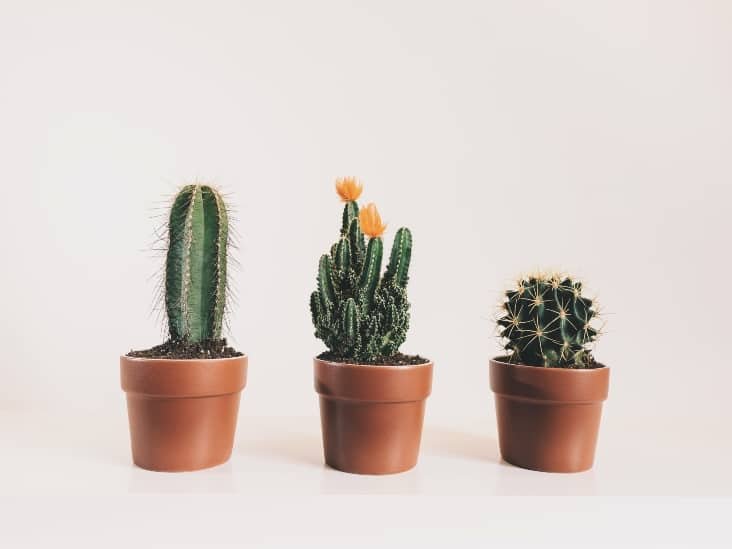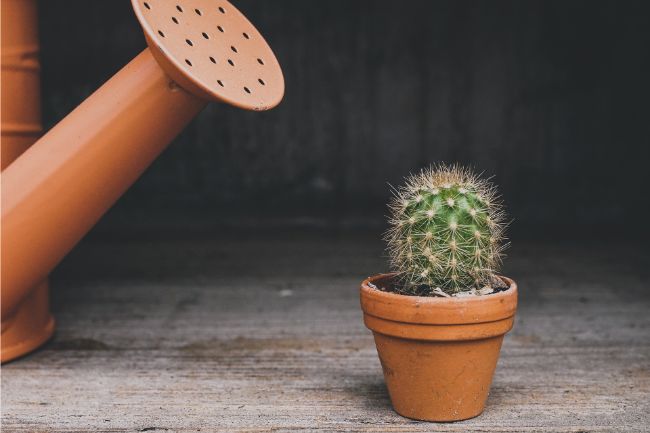5 Signs Your Cactus Needs Less Water

Cacti are known for being drought-resistant and able to store water in their fleshy stems, but they still need some water to survive. Here are 5 signs that your cactus needs less water:
The first sign is that the leaves of your cactus are starting to shrivel.
This means that the plant is not getting enough moisture and is starting to dehydrate. If you see this happening, start cutting back on the amount of water you’re giving your cactus.
Another sign that your cactus needs less water is if the stem starts to wrinkle or pucker.
This is another symptom of dehydration and means that it’s time to cut back on watering.
If your cactus starts to produce smaller leaves, this is also a sign that it’s not getting enough water. Cacti will often produce smaller leaves in an effort to conserve moisture, so if you see this happening, give your plant a good soak and then reduce the amount of water you’re giving it going forward.
Yellowing leaves can also be a sign of overwatering. If the leaves of your cactus start to turn yellow, it’s an indication that they’re not able to drain properly and are sitting in too much moisture. Cut back on watering and make sure you’re allowing the soil to dry out completely betweenwaterings.
Finally, if your cactus starts developing soft spots or mushy patches, this is a definite sign of overwatering and root rot. At this point, it’s best to stop watering altogether and let the plant dry out completely before resuming normal watering schedules.
5 COMMON MISTAKES IN CACTUS CARE
If you notice any of the following five signs, your cactus needs less water:
1. The leaves are wilting or drooping.
2. The leaves are turning yellow or brown.
3. The stem is shrinking.
4. There is mold or fungus on the plant.
5. The plant is overall dry and/or crumbly to the touch.
Cactus Too Little Water
Cacti are often thought of as desert plants that don’t need much water. However, this isn’t always the case. While cacti can survive in dry conditions, they will usually do better if they’re given a little bit of water on a regular basis.
If you’re growing cacti indoors, it’s important to give them enough light and air flow. They also like to be kept on the drier side, so make sure you don’t overwater them. When it comes to watering your cactus, the general rule is to let the soil dry out completely between watering.
This means waiting until the soil is completely dry before giving your plant another drink.
It’s also important to use a pot with drainage holes so that excess water can easily escape. Cacti that are sitting in waterlogged soil are more likely to succumb to root rot or other problems.
If you’re not sure whether or not your cactus needs water, it’s always better err on the side of caution and wait a few extra days before watering again.
How to Tell If Cactus Needs Water
If you have a cactus, it’s important to know how to tell if it needs water. Here are some tips:
1. Check the soil.
The first way to tell if your cactus needs water is to check the soil. If it’s dry, then your cactus probably needs water.
2. Look at the leaves.
Another way to tell if your cactus needs water is to look at the leaves. If they’re wilting or drooping, then it’s a good sign that your cactus needs some water.
3. Check for insect infestation.
Sometimes, insects can be a sign that your cactus needs water. If you see any bugs on your cactus, it’s a good idea to give it a drink of water right away.
4. Observe overall health.
Finally, another way to tell if your cactus needs water is by observing its overall health.
Is My Cactus Overwatered Or Underwatered
If you’re not sure whether your cactus is overwatered or underwatered, there are a few things you can look for. If the leaves of your cactus are wilting or if the stem feels soft, it’s likely that your plant is overwatered. On the other hand, if the leaves are dry and brittle or if the stem feels hard, it’s probably underwatered.
If you think your cactus might be overwatered, the best thing to do is to let it dry out completely. Stop watering it and wait a week or two to see if the plant improves. If it does, slowly start watering again, being careful not to overwater.
If your cactus doesn’t improve after a week or two, it’s possible that it has root rot and will need to be repotted with fresh soil.
If you think your cactus might be underwatered, water it thoroughly and then wait a few days to see if there’s any improvement. If not, continue watering every few days until the plant begins to recover.
Be careful not to underwater though – too much water can also be harmful to your cactus!
How Much Water Does a Small Cactus Need
A small cactus needs very little water to survive. In fact, it is best to err on the side of too little water rather than too much. Over-watering a cactus can lead to root rot, which is difficult to recover from.
When watering a small cactus, give it just enough so that the soil is moistened – but not soggy. Allow the soil to dry out completely before watering again.
How to Tell If Cactus is Underwatered
If your cactus is wilting, has wrinkled skin, or its stems are beginning to shrivel and collapse, it’s likely underwatered. Other telltale signs of an underwatered cactus include yellowing leaves (if present), slow growth, and stunted blooms.
When it comes to watering your cactus, the general rule of thumb is to water deeply but infrequently.
This means giving your cactus a thorough soaking about once a week or every ten days, allowing the water to reach the roots. During periods of hot weather or active growth, you may need to water more frequently.
If you think your cactus is underwatered, give it a good drink and then wait a few days to see if there’s any improvement.
If not, continue increasing the frequency of watering until you see results. Keep in mind that it’s better to underwater a cactus than overwater it, so err on the side of caution.

Credit: smartgardenguide.com
How Can You Tell When a Cactus Needs Water?
If your cactus is looking wilted, droopy, or generally unhappy, it may be time to give it a drink. When in doubt, err on the side of giving your cactus a little bit of water rather than too much – too much water can actually do more harm than good. Here are a few tips on how to tell when your cactus needs water:
1. Check the soil. One of the best ways to tell if your cactus needs water is to simply check the moisture level of the soil it’s growing in. If the soil feels dry to the touch, it’s probably time to give your cactus a drink.
2. Look at the leaves. Another way to tell if your cactus needs water is to take a close look at its leaves. If they appear wrinkled or shrunken, that’s an indication that they’re not getting enough moisture and your plant could use some watering.
3. Check for weight loss. Believe it or not, you can actually tell if your cactus is thirsty by picking it up and seeing how heavy it feels. A healthy, hydrated cactus will feel heavier than one that’s dehydrated and in need of water.
4. Listen for creaking sounds . This one may seem a bit strange, but apparently another way to tell if a cactus needs water is by listening for creaking sounds coming from inside the plant!
How Do I Know How Much Water to Give My Cactus?
If you’re wondering how much water to give your cactus, the answer is “it depends.” The amount of water your cactus needs will vary depending on the type of cactus, the size of the pot, the climate, and other factors.
Here are a few general tips:
-Most cacti need very little water. They are desert plants, after all! Water them only when the soil is completely dry.
Overwatering is one of the most common causes of death for cacti.
-err on the side of too little water rather than too much. It’s better to underwater a cactus than to overwater it.
-In general, smaller pots will need more frequent watering than larger pots. This is because the soil in small pots dries out more quickly.
-Cacti that are grown outdoors in hot climates will need more water than those that are grown indoors or in cooler climates.
Again, err on the side of too little water rather than too much.
Does Cactus Need Less Water?
While cacti are often thought to be plants that need very little water, this is not always the case. Depending on the type of cactus, they can actually require quite a bit of water, especially when they are young.
There are two main types of cacti – desert cacti and tropical cacti.
Desert cacti, as their name suggests, come from arid environments and have adapted to survive with very little water. They typically only need to be watered every few weeks or so, and even then only lightly.
Tropical cacti, on the other hand, come from humid rainforests and so need considerably more moisture.
They should be watered regularly – around once a week – and allowed to dry out completely between watering. Over-watering tropical cacti can lead to root rot, so it’s important not to go overboard.
So, in answer to the question “Do cactus need less water?”, it really depends on the type of cactus in question.
In general though, all cacti benefit from being grown in well-draining soil and being allowed to dry out completely between watering.
How Can I Tell If My Cactus is Overwatered?
Knowing cactus hydration signs is crucial to prevent overwatering. Look for yellowing or softening of the cactus, as these are clear indicators of excess watering. Overwatered cacti may also show root rot, with a foul smell coming from the potting mix. Remember, observing these signs can ensure the proper care and health of your cactus.
What Do Overwatered Cactus Look Like?
Overwatered cactus look like they have waterlogged stems and leaves. The leaves may be yellowed or brown, and the stem may be soft to the touch. In extreme cases, the plant may collapse entirely.
If you think your cactus is overwatered, stop watering it immediately and allow the plant to dry out completely before watering again.
Conclusion
If your cactus is looking a bit wilted, it might be time to give it a break from watering. Here are 5 signs that your cactus needs less water:
1. The leaves are starting to droop.
2. The stems are getting softer.
3. The color of the leaves is changing.
4. There is mold or fungus growing on the plant.
5. The plant is overall looking unhealthy.